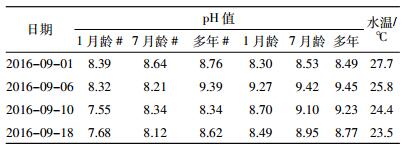文章信息
- 郭宸耀, 李强坤, 柯桂英, 胡亚伟, 宋常吉, 封慧娟, 夏瑞燕
- GUO Chen-yao, LI Qiang-kun, KE Gui-ying, HU Ya-wei, SONG Chang-ji, FENG Hui-juan, XIA Rui-yan
- 不同运行期排水沟渠中氮的净化效应实验研究
- The Purifying Effect of Nitrogen in Drainage Ditches of Different Operation Periods
- 农业资源与环境学报, 2017, 34(3): 242-249
- Journal of Agricultural Resources and Environment, 2017, 34(3): 242-249
- http://dx.doi.org/10.13254/j.jare.2016.0261
-
文章历史
- 收稿日期: 2016-11-02
2. 河海大学水利水电学院, 江苏 南京 210098;
3. 三门峡库区水文水资源局, 河南 三门峡 472000
2. College of Water Conservancy and Hydropower Engineering, Hohai University, Nanjing 210098, China;
3. Hydrology and Water Resources Bureau of Sanmenxia Reservoir, Sanmenxia 472000, China
水环境污染是造成全球水资源水质性紧缺非常重要的因素[1]。近年来,随着化肥、农药等农业投入的增加以及点源污染逐步得到控制,非点源污染尤其是农业非点源污染对水体环境质量的影响尤为显著。农业非点源污染的主要控制措施可划分为源头减量、过程拦截和末端治理三个阶段[2]。随着“生态水利”概念的提出,应用生态工程技术进行非点源污染控制和管理已成为近年来研究的前沿,植物缓冲带、人工湿地、生态沟渠等被广泛用于农业非点源污染控制[3-6]。用农田排水沟渠拦截、处理农业非点源污染的研究是人工湿地水处理技术的推广和延伸[7-9]。与其他控制措施相比,生态沟渠因其建设成本低、污染物去除率高,更适合在农村地区推广[10]。
沟渠湿地具有独特的植物-底泥-微生物系统,经植物吸收、泥沙拦截和微生物分解等理化作用,能够在某种程度上降低地表径流所携带的氮浓度[11]。Kroger等[12-13]研究发现,一条长约400 m,宽约7 m的农田排水沟对可溶性无机氮的截留率可以达到57%;徐红灯等[14]以动态和静态模拟试验为基础,探讨了水生植物对农田排水沟渠中氮的截留效应,结果表明沟渠中的水生植物对氮的截留和转化有明显的促进作用;Wu等[15]以住宅-农田复合区域为研究对象,发现生态沟渠对氮的去除率可达到48%;张树楠等[16]以运行近1年的生态沟渠为对象,发现生态沟渠对水体中总氮的平均去除率达到64.3%;王晓玲等[17]以宜兴市何家浜上游西侧的水稻耕作区为研究对象,研究发现该区域的一段自然排水沟渠改造的生态沟渠对氮的平均去除率为31.4%;李强坤等[18]通过模拟排水沟渠对比试验,结果表明底泥的吸附与解吸、芦苇生长的吸收和同化对水中氮素在10月之前表现为促进水中氮素浓度降低,10月之后净化作用开始降低,11月之后表现为促进水体中氮素浓度升高。可见,目前在农田排水沟渠研究中作为沟渠固定属性的沟渠运行期往往被忽略,将其作为自变量进行研究的较少。本文以模拟运行期分别为1月龄、7月龄和多年的排水沟渠静态实验为基础,以典型非点源溶质氮素为例,比较不同运行期对排水沟渠中氮素净化效应的差异,以期进一步地探究排水沟渠发育过程,从而为农地整理中排水沟渠的重建和生态化建设提供科学依据。
1 材料与方法 1.1 实验布置模拟沟渠实验布置在黄河水利科学研究院节水与农业生态实验基地(35°18′N,113°53′E)。该区属于温带大陆性季风气候,海拔73.2 m,多年平均气温14.1 ℃,无霜期210 d,日照时数2 398.8 h,年平均降水量582 mm,6—10月降雨量占全年降水量的70%~80%。
试验选用6 L塑料桶6个,设计两组模拟沟渠(桶高26.5 cm,桶底和桶口直径分别为17 cm和20.3 cm,底泥深度约为15 cm,水深10 cm):一组用运行期分别为1月龄、7月龄和多年且生长有1株芦苇的原状沟渠底泥装填,约30株·m-2,芦苇长势较一致,为生态沟渠;另一组仅用原状沟渠底泥装填,为非生态沟渠(如图 1所示),实验装置布置在遮雨棚下,沟渠底泥初始理化性质见表 1。
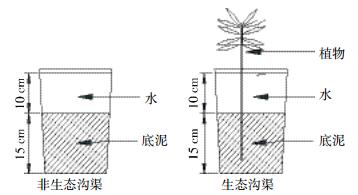
|
| 图 1 实验装置断面示意图 Figure 1 Cross-section of the experimental equipment |
本项试验历时18 d。实验开始时,参照李强坤[7]作物生长期旱田农沟污染物浓度统计特征值总氮浓度范围为3.896~13.063 mg·L-1,模拟农田排水高浓度情况,采用纯度为99.8%的NH4NO3(国药集团)配制总氮浓度为12 mg·L-1的混合溶液。2016年9月1日统一加入预配的NH4NO3溶液2 200 mL,按加水静置2 h后第一次取样浓度进入试验。
1.3 样本提取和分析2016年9月1日注水2 h后第一次取样,实验前期每日取样1次,待溶液浓度稳定后每2 d取样1次(共取样15次)。用注射针筒吸取上覆水,每次取样20 mL,同时测定上覆水的pH值、温度等,每次取样后用纯水将水位补充至初始水位。由于NH4+离子易转化为气态NH3,挥发进入大气,因此氮的挥发在实验中不计入分析。上覆水的理化性质见表 2。
样品提取后经0.45 μm膜过滤后按照文献[19]进行实验室化验分析,分析指标包括氨氮、硝氮浓度,主要分析仪器为Smartchem140全自动化学分析仪。
1.4 数据分析采用Microsoft Excel 2010软件作图,浓度变化过程与运行期的回归分析采用SPSS13.0软件进行,拟定统计检验的显著性水平P=0.05。
为进一步量化分析期间差异,研究中引入净化速率V,计算公式见公式(1):

|
(1) |
式中:V为净化速率,mg·L-1·d-1;C1、C2为模拟箱水体中氮素浓度,mg·L-1;T为时间间隔,d。
2 结果与分析 2.1 沟渠中NH4+-N和NO3--N浓度变化选取2016年9月1日至2016年9月18日时段实验资料,点绘生态沟渠和非生态沟渠水体中氨氮和硝氮的浓度曲线,见图 2和图 3。
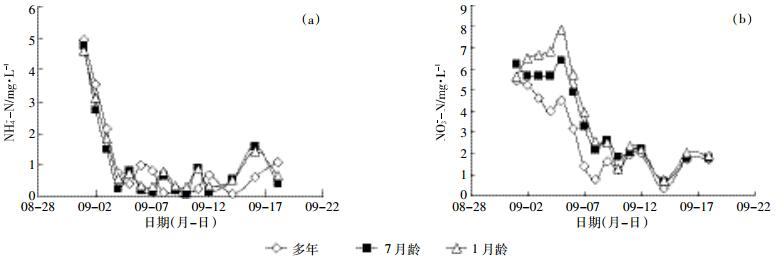
|
| 图 2 非生态沟渠中NH4+-N和NO3--N浓度变化 Figure 2 Changes of NH4+-N and NO3--N in the non-ecological ditch |
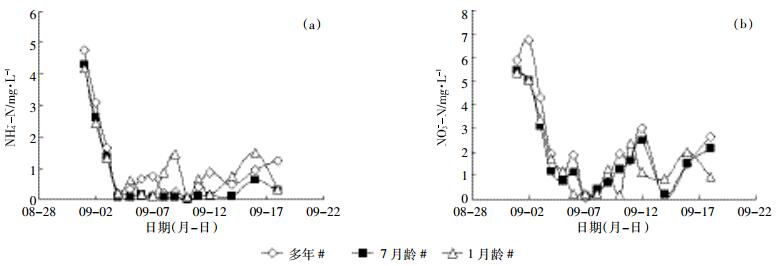
|
| 图 3 生态沟渠中NH4+-N和NO3--N浓度变化 Figure 3 Changes of NH4+-N and NO3--N in the ecological ditch |
从图 2和图 3中可以看出,水体中氮素浓度变化具有以下几个特征:① 不同运行期的生态沟渠和非生态沟渠对水中的氮素具有较强的净化作用,氮素浓度在实验初期快速下降,待下降至第一个浓度较低值后,趋于平缓,呈现出“快速净化,波动平衡”的特点;② 与非生态沟渠中氨氮浓度快速下降至第一个浓度较低值不同,1月龄非生态沟渠中硝氮浓度直接升高,7月龄和多年非生态沟渠中硝氮浓度则先降后升,与1月龄沟渠同时达到第一次峰值,然后三者降低至第一次浓度较低值,且硝氮浓度下降至第一个浓度较低值的时间(9月8日)晚于氨氮(9月5日)。其原因是沟渠沉积物是氮的容纳场所,1月龄非生态沟渠运行期较短,还没有足够的时间来富集有机质,从而限制了反硝化细菌的大量繁殖,降低了沟渠的硝化作用,同时1月龄非生态沟渠底泥中硝氮的含量最高(表 1),从而为沟渠沉积物中的氮素向上覆水中的释放提供了条件;③ 在实验初期,不同运行期生态沟渠中氨氮和硝氮浓度均快速下降,且分别早于非生态沟渠氨氮和硝氮浓度下降至第一个浓度较低值的时间(氨氮:9月4日,硝氮:9月5日);④ 生态沟渠和非生态沟渠中硝氮“波动平衡”的浓度范围(≤3 mg·L-1)高于氨氮(≤2 mg·L-1);⑤ 经显著性分析可知,不同运行期生态沟渠中氨氮和硝氮的净化过程无显著性差异,而非生态沟渠中硝氮的净化过程在实验初期(9月1日至9月6日)有显著性差异(尾概率P=0.01<0.05,见表 3)。

|
从图 4中可以看出,随着运行期的增加,沟渠中硝氮的净化过程总体上呈现拟合趋势,经显著性分析,1月龄和7月龄生态沟渠和非生态沟渠中硝氮的净化过程在整个实验期均有显著性差异,多年运行期沟渠中硝氮的净化过程无显著性差异,氨氮的净化过程无显著性差异(见表 4)。
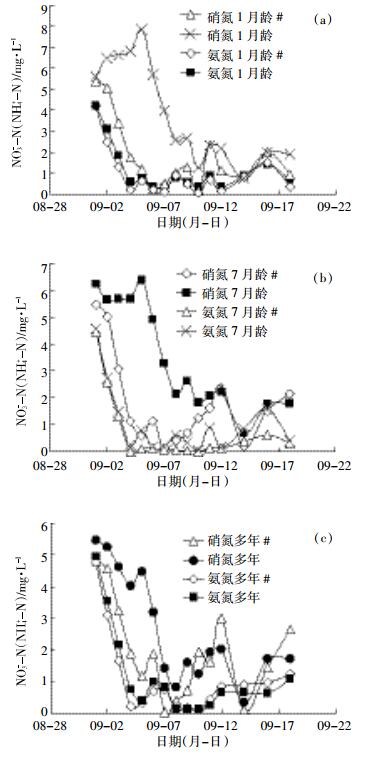
|
| 图 4 不同运行期排水沟渠中NH4+-N和NO3--N浓度变化 Figure 4 Changes of NH4+-N and NO3--N in the drainage ditches of different operating periods |

|
通过公式(1)的计算,点绘生态沟渠和非生态沟渠中氨氮和硝氮净化速率曲线,见图 5~图 7。

|
| 图 5 非生态沟渠中氮素的净化速率 Figure 5 The purification rate of nitrogen in the non-ecological ditch |
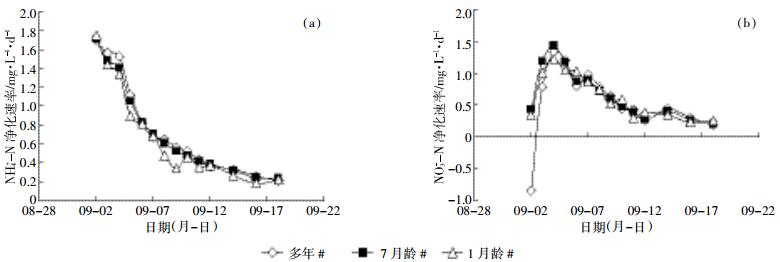
|
| 图 6 生态沟渠中氮素的净化速率 Figure 6 The purification rate of nitrogen in the ecological ditch |
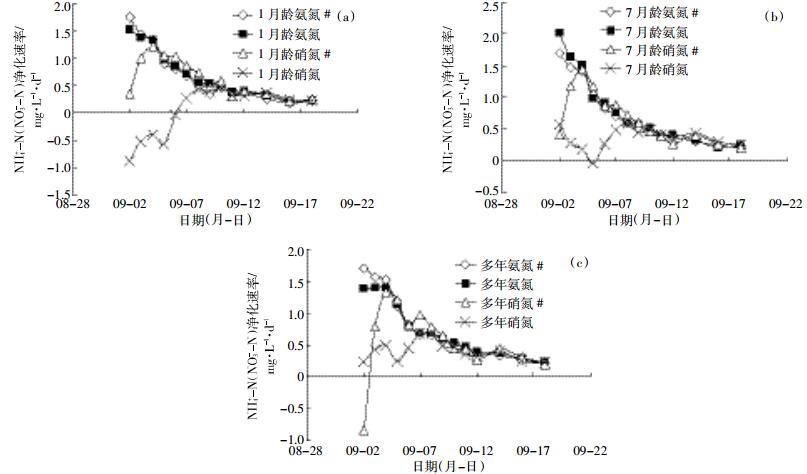
|
| 图 7 不同运行期排水沟渠中氮素的净化速率 Figure 7 The purification rate of nitrogen in drainage ditches of different operating periods |
从图 5~图 7中可以看出,生态沟渠和非生态沟渠中氮素的净化过程有以下几个特征:① 生态沟渠和非生态沟渠中氨氮的净化速率呈递减的趋势,逐渐趋于平缓,且氨氮的净化速率总体分布上:多年>7月龄>1月龄,说明不论有无水生植物,排水沟渠均对氨氮具有较强的净化作用,且随着运行期的增长,氨氮的净化速率有所增加,但无显著性差异(见表 5);② 生态沟渠中硝氮的净化速率先增后减,不同运行期生态沟渠中硝氮的净化速率无显著性差异(见表 5),说明在实验初期,反硝化作用的强度逐渐增强,并于9月4日达到最高,随着NO3-浓度的减少,反硝化速率降低;③ 与生态沟渠中硝氮的净化过程不同,不同运行期非生态沟渠中硝氮的净化过程有显著性差异(9月2日—9月8日:P=0.001<0.05,9月2日—9月18日:P=0.002<0.05),且净化速率比较:多年>7月龄>1月龄;④ 1月龄非生态沟渠和生态沟渠中硝氮净化速率在实验初期均出现了负值(图 5(b)、图 6(b)),这与1月龄沟渠底泥中硝氮的含量高于7月龄和多年(见表 1),使得在实验初期,沉积物间隙水中硝氮的含量高于上覆水中氮的含量,溶解的氮被释放到上覆水中,同时说明在实验初期1月龄沟渠净化速率少于硝氮向上覆水中释放的速度;⑤ 同一运行期生态沟渠中硝氮和氨氮的净化速率均大于非生态沟渠,这说明生态沟渠中水生植物的存在加速了氮素的界面交换,其他条件相同时,可以截留更多氮素。

|
通过前文分析可以看出,不同运行期沟渠对水体中氨氮、硝氮均具有较强的净化作用。生态沟渠对氮素的拦截主要通过植物吸收、微生物硝化和反硝化作用以及底泥的吸附等过程实现[20-21]。氮素是植物生长所必需的营养元素,以离子形式存在的无机态氮(NH4+-N和NO3--N)能够被生态沟渠中的植物直接吸收利用而去除,同时植物在生长过程中不断向根部输送氧气而形成根区好氧微环境,有助于硝化细菌的生长,为硝化细菌将NH4+-N转化为NO3--N提供条件,同时与反硝化细菌在根区以外的缺氧或厌氧条件下的反硝化作用相结合,最终将NO3--N转化为气态N2和N2O,而使得水体氮素得到去除[22-23]。另外由于底泥中土壤胶体颗粒带负电荷,能更好地吸附NH4+-N,促进NH4+-N被吸附固定,因此,沟渠中NH4+-N的去除率要高于NO3--N。这与试验中相同运行期排水沟渠中氨氮的净化速率高于硝氮,NO3--N的平衡浓度范围(≤3 mg·L-1)在实验后期高于NH4+-N浓度波动平衡的浓度范围(≤2 mg·L-1)结果一致。
不同运行期非生态沟渠中氨氮和硝氮浓度表现为:多年沟渠<7月龄沟渠<1月龄沟渠,氨氮的浓度变化过程无显著差异,硝氮的浓度变化在实验初期(9月1日—9月6日)有显著性差异(尾概率P=0.001<0.05),这与不同运行期沟渠底泥中硝化细菌和反硝化细菌的数量差异与生物特性有较大关系,随着运行期的增加,非生态沟渠底泥富集了更多的机质,使得反硝化细菌的数量大量繁殖,同时非生态沟渠底泥中的缺氧环境有利于反硝化作用的发生,使得NO3--N转化成气态的N2和N2O逸出,但抑制了硝化细菌的反硝化作用。
在实验初期,相同运行期生态沟渠中硝氮的净化速率均高于非生态沟渠,而氨氮的净化速率无显著性差异,这与张树楠等[16]研究表明沟渠沉积物对氨氮的吸附具有“快速吸附,缓慢平衡”和对硝氮具有“快速硝化,缓慢平衡”的特点类似,说明在实验初期,沟渠沉积物的吸附在氨氮的净化中起主导作用,故有无水生植物对氨氮的净化速率无显著性影响;植物根系的泌氧特性,使得水生植物根际底泥氧化还原层分异,促进生物硝化和反硝化作用的发生[24]。
4 结论(1)不同运行期排水沟渠对水中氨氮、硝氮具有较强的净化效应,净化过程表现出“快速下降,波动平衡”的特点,氨氮浓度的下降速度快于硝氮,氨氮浓度波动平衡的浓度范围(≤2 mg·L-1)低于硝氮浓度的波动平衡范围(≤3 mg·L-1)。
(2)生态沟渠和非生态沟渠中氨氮浓度的变化过程,除7月龄沟渠“波动平衡”阶段有显著性差异(P=0.03<0.05),其余阶段无显著性差异;1月龄沟渠和7月龄沟渠中硝氮浓度的变化过程,在实验初期和“波动平衡”阶段均有显著性差异,多年沟渠的净化趋势相似,无显著性差异。
(3)运行期的不同对实验初始阶段排水沟渠中氨氮和硝氮的净化速率有较大的影响,初始阶段的净化速率比较为:多年>7月龄>1月龄;除不同运行期非生态沟渠中硝氮的净化速率有显著性差异外,其余阶段无显著性差异。
(4)本实验初步证明在增长沟渠运行期能够提高沟渠氮素净化能力的基础上,研究了不同运行期沟渠对硝氮和氨氮净化效应的差异,对进一步探究排水沟渠的发育过程和生态沟渠的合理化设计与管理具有一定的借鉴意义。但在沟渠底泥微生物方面的研究尚有欠缺,对造成不同运行期沟渠净化能力差异的原因也有待进一步深入探讨。
| [1] | 罗良国, 陈崇娟, 赵天成, 等. 植物修复农田退水氮、磷污染研究进展[J]. 农业资源与环境学报, 2016, 33(1): 1–9. LUO Liang-guo, CHEN Chong-juan, ZHAO Tian-cheng, et al. Progress on phytoremediation of drainage water N and P pollution in farmland drainage ditches:A review[J]. Journal of Agricultural Resources and Environment, 2016, 33(1): 1–9. (in Chinese) |
| [2] | 李强坤, 胡亚伟, 孙娟. 农业非点源污染物在排水沟渠中的迁移转化研究进展[J]. 中国生态农业学报, 2010, 18(1): 210–214. LI Qiang-kun, HU Ya-wei, SUN Juan. Migration and transformation of agricultural non-point source pollutants in drainage ditches[J]. Chinese Journal of Eco-Agriculture, 2010, 18(1): 210–214. (in Chinese) |
| [3] | Liu F, Xiao R L, Wang Y, et al. Effect of a novel constructed drainage ditch on the phosphorus sorption capacity of ditch soils in an agricultural headwater catchment in subtropical central China[J]. Ecological Engineering, 2013, 58: 69–76. DOI:10.1016/j.ecoleng.2013.06.008 |
| [4] | Coban O, Kuschk P, Kappelmeyer U, et al. Nitrogen transforming community in a horizzontal subsurface-flow constructed wetland[J]. Water Research, 2015, 74: 203–212. DOI:10.1016/j.watres.2015.02.018 |
| [5] | Kaushal S S, Groffman P M, Band L E, et al. Tracking non-point source nitrogen pollution in human-impacted watersheds[J]. Environmental Science & Technology, 2011, 45(19): 8225–8232. |
| [6] | 周俊, 邓伟, 刘伟龙. 沟渠湿地的水文和生态环境效应研究进展[J]. 地球科学进展, 2008, 23(10): 1079–1083. ZHOU Jun, DENG Wei, LIU Wei-long. Advances on the effects of ditch wetland on hydrology and eco-environment[J]. Advances in Earth Science, 2008, 23(10): 1079–1083. DOI:10.3321/j.issn:1001-8166.2008.10.010 (in Chinese) |
| [7] | 李强坤. 青铜峡灌区农业非点源污染负荷及控制措施研究[D]. 西安: 西安理工大学, 2010. LI Qiang-kun. Study on the loads and control measures of agricultural non-point source pollution in Qing Tong Xia irrigation district[D]. Xi'an:Xi'an University of Technology, 2010.(in Chinese) |
| [8] | Needelman B A, Kleinman P J A, Strock J S, et al. Improved management of agricultural drainage ditches for water quality protection:An overview[J]. Journal of Soil and Water Conservation, 2007, 62(4): 171–178. |
| [9] | Strock J S, Dell C J, Schmidt J P. Managing natural processes in drainage ditches for nonpoint source nitrogen control[J]. Journal of Soil and Water Conservation, 2007, 62(4): 188–196. |
| [10] | Bennett E R, Moore M T, Cooper C M, et al. Vegetated agricultural drainage ditches for the mitigation of pyrethroid-associated runoff[J]. Environmental Toxicology and Chemistry, 2005, 24(9): 2121–2127. DOI:10.1897/04-357R.1 |
| [11] | 姜翠玲, 崔广柏. 湿地对农业非点源污染的去除效应[J]. 农业环境保护, 2002, 21(5): 471–473. JIANG Cui-ling, CUI Guang-bo. Effectivesness of wetlands in removal of non-point pollutants from agricultural source[J]. Agro-Environmental Protection, 2002, 21(5): 471–473. (in Chinese) |
| [12] | Kroger R, Holland M M, Moore M T, et al. Hydrological variability and agricultural drainage ditch inorganic nitrogen reduction capacity[J]. Journal of Environmental Quality, 2007, 36(6): 1646–1652. DOI:10.2134/jeq2006.0506 |
| [13] | Kroger R, Holland M M, Moore M T, et al. Agricultural drainage ditches mitigate phosphorus loads as a function of hydrological variability[J]. Journal of Environmental Quality, 2008, 37(1): 107–113. DOI:10.2134/jeq2006.0505 |
| [14] | 徐红灯, 席北斗, 王京刚, 等. 水生植物对农田排水沟渠中氮、磷的截留效应[J]. 环境科学研究, 2007, 20(2): 84–88. XU Hong-deng, XI Bei-dou, WANG Jing-gang, et al. Study on the interception of nitrogen and phosphorus by macrophyte in agriculture drainage ditch[J]. Research of Environmental Sciences, 2007, 20(2): 84–88. (in Chinese) |
| [15] | Wu Y H, Kerr P G, Hu Z Y, et al. Eco-restoration:Simultaneous nutrient removal from soil and water in a complex residential-cropland area[J]. Environmental Pollution, 2010, 158(7): 2472–2477. DOI:10.1016/j.envpol.2010.03.020 |
| [16] | 张树楠, 肖润林, 刘峰, 等. 生态沟渠对氮磷污染物的拦截效应[J]. 环境科学, 2015, 36(12): 4516–4522. ZHANG Shu-nan, XIAO Run-lin, LIU Feng, et al. Interception effect of vegetated drainage ditch on nitrogen and phosphorus from drainage ditches[J]. Environmental Science, 2015, 36(12): 4516–4522. (in Chinese) |
| [17] | 王晓玲, 乔斌, 李松敏, 等. 生态沟渠对水稻不同生长期降雨径流氮磷的拦截效应研究[J]. 水利学报, 2015, 46(12): 1406–1413. WANG Xiao-ling, QIAO Bin, LI Song-min, et al. Studies on the interception effects of ecological ditch on nitrogen and phosphorus in the rainfall runoff of different rice growth period[J]. Journal of Hydraulic Engineering, 2015, 46(12): 1406–1413. (in Chinese) |
| [18] | 李强坤, 宋常吉, 胡亚伟, 等. 模拟排水沟渠非点源溶质氮迁移实验研究[J]. 环境科学, 2016, 37(2): 520–526. LI Qiang-kun, SONG Chang-ji, HU Ya-wei, et al. Transformation of non-point source soluble nitrogen in simulated drainage ditch[J]. Environmental Science, 2016, 37(2): 520–526. (in Chinese) |
| [19] | 国家环境保护局. 水和废水监测分析方法 (第四版)[M]. 北京: 中国环境科学出版社, 2002. State Environmental Protection Administration of China (SEPA). Water and wastewater monitoring and analysis methods (4th Edition)[M]. Beijing: China Environmental Science Press, 2002. (in Chinese) |
| [20] | 卢少勇, 金相灿, 余刚. 人工湿地的氮去除机理[J]. 生态学报, 2006, 26(8): 2670–2677. LU Shao-yong, JIN Xiang-can, YU Gang. Nitrogen removal mechanism of constructed wetland[J]. Acta Ecologica Sinica, 2006, 26(8): 2670–2677. (in Chinese) |
| [21] | Stottmeister U, WieBner A, Kuschk P, et al. Effects of plants and microorganisms in constructed wetlands for wastewater treatment[J]. Biotechnology Advances, 2003, 22(1-2): 93–117. DOI:10.1016/j.biotechadv.2003.08.010 |
| [22] | 罗专溪, 朱波, 唐家良, 等. 自然沟渠控制村镇降雨径流中氮磷污染的主要作用机制[J]. 环境科学学报, 2009, 29(3): 561–568. LUO Zhuan-xi, ZHU Bo, TANG Jia-liang, et al. Primary mechanisms of nitrogen and phosphorus removal from storm water runoff by a natural ditch in a rural township[J]. Acta Scientiae Circumstantiae, 2009, 29(3): 561–568. (in Chinese) |
| [23] | Cooper P F, Findlater B C. Constructed wetlands in water pollution control[M]. Perganmon Press, 1990. |
| [24] | 俞慎, 李振高. 稻田生态系统生物硝化、反硝化作用与氮素损失[J]. 应用生态学报, 1999, 10(5): 630–634. YU Shen, LI Zhen-gao. Biological nitrification-denitrification and nitrogen loss in rice field ecosystem[J]. Chinese Journal of Applied Ecology, 1999, 10(5): 630–634. (in Chinese) |
 2017, Vol. 34
2017, Vol. 34






